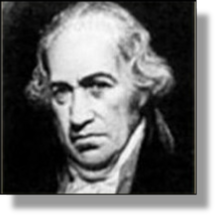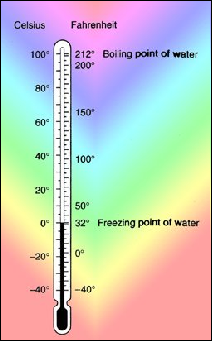


xxxxxThe German physicist Gabriel Daniel Fahrenheit showed an interest in thermometers from an early age, and in 1714 constructed the first one to use mercury instead of alcohol. Within ten years he had greatly improved its accuracy and devised a temperature scale based upon it. This scale, which came to be known by his name, put freezing point at 32 degrees and boiling point at 212. As we shall see, another temperature scale was invented by the Swedish astronomer Anders Celsius in 1742 (G2). Fahrenheit also made an improved version of the meteorological hygrometer to measure water vapour in the air.
 xxxxxThe German physicist Gabriel Daniel Fahrenheit was born in Danzig (now Gdansk in Poland), but he spent most of his working life in Holland making precision meteorological instruments. He learnt his trade in Amsterdam, beginning in 1701, and then spent some years travelling around Europe before making Holland his home.
xxxxxThe German physicist Gabriel Daniel Fahrenheit was born in Danzig (now Gdansk in Poland), but he spent most of his working life in Holland making precision meteorological instruments. He learnt his trade in Amsterdam, beginning in 1701, and then spent some years travelling around Europe before making Holland his home.
xxxxxFrom an early stage, Fahrenheit showed a particular interest in the workings of the thermometer. Like the Danish astronomer Ole Romer, who had experimented with thermometers around the turn of the century, Fahrenheit first used a column of alcohol in his instruments, but came to the conclusion that mercury would be more efficient because its rate of expansion was more constant, and it was effective over a much wider temperature range.
 xxxxxIt was in 1714 that he constructed the first practical thermometer employing mercury instead of alcohol, and within ten years he had developed his prototype into a highly accurate instrument, and devised a temperature scale based upon it. After some adjustments to this scale -
xxxxxIt was in 1714 that he constructed the first practical thermometer employing mercury instead of alcohol, and within ten years he had developed his prototype into a highly accurate instrument, and devised a temperature scale based upon it. After some adjustments to this scale -
xxxxxHis invention of the superior, mercury thermometer enabled him to determine the boiling point of liquids other than water, and to demonstrate that these varied with changes of atmospheric pressure. He was also responsible for a much improved version of the meteorological hygrometer, an instrument used to measure the humidity, or amount of water vapour, in the air.
xxxxxIncidentally, because of its size -
xxxxx…… As noted earlier, Fahrenheit’s temperature scale was a modified version of the scale produced by Romer in 1701.
GABRIEL DANIEL FAHRENHEIT 1686 -
Acknowledgement
Fahrenheit: date and artist unknown.
G1-


